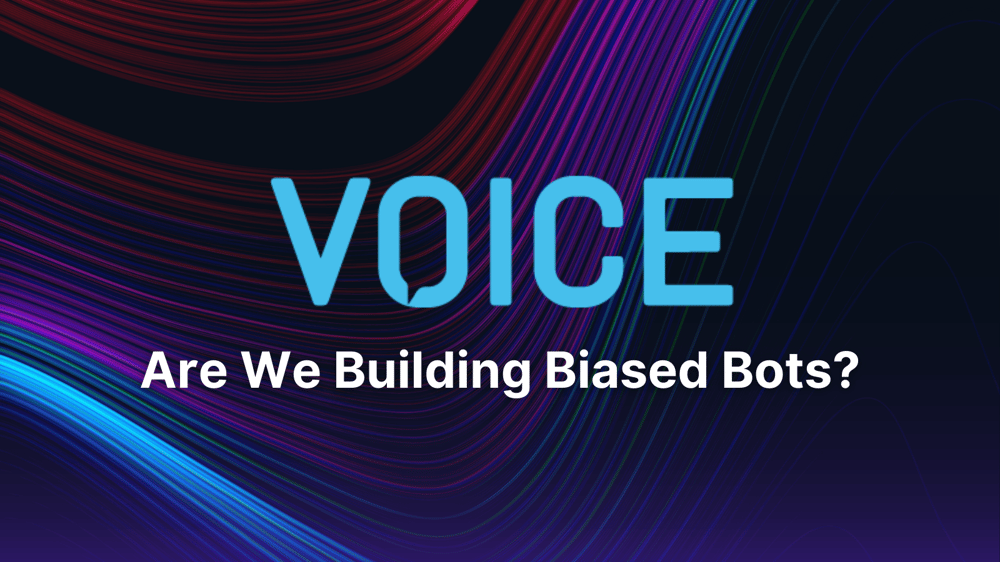Are We Building Biased Bots?
Modev News VOICE Summit 22-07-26 Modev Staff Writers 4 min read

In 2016, Microsoft conducted an interesting experiment. It unveiled Tay, a chatbot the company had built and made it available online for people worldwide to interact with. The idea was that Tay would learn from all its interactions to become smarter and smarter, making Tay a more convincing (i.e., human) communicator. But things quickly turned sour. It wasn't that Tay didn't become convincing. She became racist.
That's right, only after a few hours of being online Tay started outputting racist comments. That didn't happen due to any of Microsoft's programming. It happened because of the way machine learning works: learning from input. AI-powered chatbots are a lot like children in that they learn by example. AI systems are designed to process vast swaths of data to form predictions about the world and act accordingly. AI solutions are trained by humans and synthesize patterns from that training. Hence, as more and more users input racist statements, Tay was actually being trained to be racist, and her output started to reflect that. Garbage in, garbage out, as they say…
Thankfully, Tay was taken offline shortly after her "conversion." But it does highlight an important issue concerning AI-powered voice tech: building bias into our bots. Humans have biases - that's pretty uncontroversial - and most of our biases are unconscious. So, to some degree, some bias transfer will be inevitable. But is there anything we can do to at least limit some of the biases we build into our bots?
This post looks at some of the ways this can be achieved.
Adopt Inclusive Data Strategies
Within the context of artificial intelligence, data strategies are not simply technical decisions. They also have an ethical component. If the data sets we use to train our bots aren't representative of their users, our bots will be biased, make the wrong assumptions, and yield low-accuracy results. That's not exactly what we want.
There are essentially two approaches to training an AI bot: feeding it data sets or the more hands-off approach of letting users interact with the bot and using those interactions as training. We saw how the latter approach turned out for Microsoft...
To effectively reduce bias, a hybrid approach should be taken. You want to feed your bot datasets from a wide variety of demographics while training it with real users as well. The benefit of this approach is that the bot can self-correct for certain biases coming from one source (say user interaction) with the other source (diverse datasets).
After a certain amount of time, test your bot for biases. If you feel your bot still needs an ethical tweak or two, you can supplement its training with additional datasets. Or you can create synthetic training questions (i.e., manually train your bot to correct the bias). And remember that this is an ongoing iterative process - your bot should always be learning.
The bottom line is that your bot will only be as inclusive as your training data is diverse.
Design Inclusive UIs
So you've trained your bot with diversity and inclusiveness in mind. Great. But what about the user interface used to interact with it? How inclusive is it? Let me clarify that question with an example.
Let's say you designed a bot to answer medical questions. You've trained your bot with diverse data sets and users from varied demographics for it to be able to work for everyone, regardless of gender, age, race, etc. However, in sifting through your analytics, you find those primarily using your bot are people under the age of 60. So you scratch your head wondering why until you look at the app's UI and notice that while the UI looks good, the font it uses is tiny - a common deterrent for older users. Perhaps using a bigger font could reduce that access barrier and make it easier for that group to interact with your bot.
Biases aren't just built into bots. You need a holistic approach to inclusive design that encompasses your UI, website, marketing, etc.
Make Sure Your Development Team is as Diverse as Possible
While bots are high-tech, they also have a distinctly human dimension to them: they're a reflection of those who designed them. Because most biases are unconscious, designers and developers will be blind to the fact they're introducing bias because, by definition, they don't realize they're biased.
Having diverse design and development teams in an open environment that promotes sharing ideas is an excellent way to minimize bias. This approach has the benefit of letting humans be humans and uses group dynamics as a self-correction mechanism. By "group dynamics," I'm referring to the fact that in a diverse team, each member (with their different backgrounds) may be more sensitive to and able to flag certain biases that the rest of the team is simply not aware of. In a less diverse team, that bias may well have flown under the radar and made it into the final product. The more diverse your teams are, the better your results will be.
Remember, humans build bots. And bots learn by example. So it's up to us humans to set the proper example.
About Modev
Modev was founded in 2008 on the simple belief that human connection is vital in the era of digital transformation. Today, Modev produces market-leading events such as VOICE Global, presented by Google Assistant, VOICE Summit, and the award-winning VOICE Talks internet talk show. Modev staff, better known as "Modevators," include community building and transformation experts worldwide. To learn more about Modev, and the breadth of events offered live and virtually, visit modev.com.